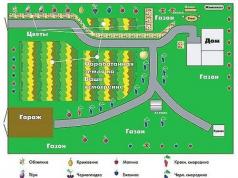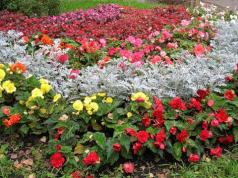Plants that repel pests have long been used by people to protect their backyard plantings. Possessing a specific aroma, these "green assistants" are able to disorient or scare away uninvited guests from the site, thereby contributing to the preservation of the harvest. What kind of plants with similar properties are we talking about?
Plants that repel pests: names
The list of plants that can assist in the fight against harmful insects is actually very large: it contains noble flowers, and herbs, and vegetables, and even some weeds. It should be noted that most of them can successfully fit into your garden or garden without disturbing the unity and harmony of the surrounding landscape.
Marigold
Sunny, bright orange and lemon yellow marigolds, for example, are known to many backyard owners as the most popular border flowers. However, only experienced summer residents know that marigolds (especially low-growing varieties) not only decorate the site, but also scare off many different pests.
So, it has been noticed that these charming flowers cause rejection among bears (cabbage), nematodes, carrot flies and other uninvited guests who are ready to take a fancy to the garden crops they like. To make the fight against nematodes and carrot flies even more effective, it is recommended to plant marigolds not in the aisles, but alternating them directly on the beds with carrots, strawberries and other vulnerable plants. It should be noted that, although the nematode penetrates into these flowers, after that it loses its ability to reproduce, so by next year the bed will be cleared of it.
Marigold or calendula
These touching flowers, as well as marigolds, are capable of repelling the nematode that affects the plantings of strawberries. In addition, the presence of calendula on the site repels pests such as:
- - bear;
- - asparagus rattle;
- - caterpillars of the five-point hawk moth.
It has been noticed that the unobtrusive scent of marigolds is unpleasant for many other well-known insects that threaten to cause damage to fruit trees and berry bushes. At the same time, the smell of calendula, according to experienced summer residents, is attractive to ladybirds, which are one of the main enemies of aphids.
You can plant marigolds right in the middle of the garden (near or among the plantings), and under trees in a fruit, berry or natural garden. Due to their perky appearance, these plants will add bright colors to the surrounding landscape and at the same time - protect your future harvest from pests.
Pyrethrum
Chrysanthemums
These graceful flowers have a characteristic delicate scent that repels pests such as bears. To reduce the risk of these insects appearing on the site, experienced summer residents recommend planting low-growing varieties of chrysanthemums in the aisles and among the plantings in the garden and in the garden.
Pelargonium (geranium)
The specific smell of geranium is unpleasant for many insects that damage vegetable and berry crops. Experienced gardeners argue that pots and containers with geraniums, placed on the site and among the plantings, help prevent the invasion of aphids, cabbage, leafhoppers, scoops. In addition, it is believed that these plants scare away mosquitoes and midges.
Tansy
 This perennial, considered a weed among summer residents, contains essential oils in its flowers and leaves, the characteristic aroma of which is unpleasant for insects, in particular, such as:
This perennial, considered a weed among summer residents, contains essential oils in its flowers and leaves, the characteristic aroma of which is unpleasant for insects, in particular, such as:
- - fleas;
- - flies;
- - mosquitoes;
- - pests of vegetable and berry crops.
It has been noticed that the strong smell of tansy scares off the moth, but it is not at all necessary to plant this perennial near your garden plantings. It is enough to tie bunches of freshly picked tansy to the branches of fruit trees in the summer.
Sagebrush
Another common plant that repels garden pests. In particular, insects such as:
- - moths;
- - ants;
- - cabbage flies;
- - whiteflies;
- - cabbage whites;
- - fleas.
The bitter-spicy aroma of wormwood is not to the liking of hares that visit country gardens in winter. To provide wintering trees with additional protection from these rodents, some summer residents hang bunches of wormwood on the periphery of the crowns and tie them to covered stems.
White mustard
Despite the fact that white mustard is better known as a weed, it is, among other things, a good repellent and can help protect garden plantings. According to seasoned summer residents, in the crops of peas, with which white mustard adjoins, the activity of the pea moth is noticeably reduced. Aphids and wireworms also avoid it.
Elderberry black
This deciduous shrub has been successfully used by many gardeners to combat gooseberry and currant pests. In particular, the presence of elderberry on the site is not to the taste of such insects as:
- - moths;
- - gooseberry moths;
- - moths;
- - currant kidney mites, etc.
To protect your berry garden from the invasion of these uninvited guests, it is enough to place freshly cut elderberry branches in jars of water and place them in the middle or between currant and gooseberry bushes. It is allowed to use instead of the black elderberry its close relative - the red elderberry, which, according to some gardeners, is also effective against mice. There is an opinion that in places where the red elderberry grows, these rodents are not found.
Tomatoes
Experienced gardeners say that the characteristic sweet-tart aroma of tomato leaves is unpleasant for aphids and suckers, sawflies, moths and asparagus crackers. Thanks to this, tomatoes are able to provide additional protection for gooseberries, asparagus, as well as for melons and cabbage crops.
Beans
This graceful climbing culture helps not only to decorate the garden and vegetable garden, but also to protect them from the most famous pests. Planting beans next to potatoes is believed to discourage voracious Colorado beetles and wireworms.
In addition, some members of the legume family (in particular, lima beans) are known to be quite effective repellents - i.e. plants that repel mosquitoes, midges, etc. In view of these features, lima (as this variety of beans is also called) is often planted near gazebos, used to decorate open verandas, patios and other recreation areas on the site.
Onion and garlic
According to experienced gardeners, the smell of garlic and onions scares away many well-known pests of strawberries and strawberries, and the phytoncides that these plants exude help to destroy the pathogens of gray rot. For this reason, it is recommended to plant onions and garlic in the middle (or nearby) of the most vulnerable fruit and berry crops.
It has also been noticed that carrot fly, a well-known pest that can cause serious damage to future crops, avoids onion planting. It is believed that the proximity of onions and carrots is mutually beneficial, since onion phytoncides scare away carrot flies, and carrot phytoncides scare off onions.
Thus, the crops of garlic, located in tomatoes, turnips, cabbage, radishes and radishes, will provide additional protection to vegetable crops and, thereby, contribute to the preservation of your future harvest.
Sage
The practical experience of many summer residents shows that the sage aroma is unpleasant for common pests of cabbage and carrots - in particular, carrot and cabbage flies, white flies, cabbage scoops.
Basil and celery
It is believed that basil and celery repel mosquitoes well, as a result of which these herbs are often planted in beds or in containers near verandas, patios, swimming pools and ornamental ponds. In addition, celery and basil bushes growing in a vegetable garden among cruciferous crops will make vegetable planting unattractive for cabbage and cabbage flies.
Of course, the presented list of plants that repel mosquitoes, midges, ticks, the Colorado potato beetle and other insects is incomplete. However, whichever “green defender” you prefer, do not forget that you can effectively resist pests only through the use of integrated control measures. Do not forget about the use of other methods of protecting garden plantations from pests - and you will be able to give a powerful rebuff to uninvited guests.








